How To Gain More Customers With Video Content: The Definitive Guide
If you’re hungry for more customers but don’t see any reason to promote your business with video content, you’re making a huge mistake.
A large number of people consume video content on a regular basis, leading to the growing popularity of videos for some years now.
Observing this trend, shrewd entrepreneurs and businesses started creating and posting interesting videos online to grab and keep the attention of their target audience.
And you know what?
Not only did they attract and engage them, they also managed to convert a lot of them successfully, with video content.
Want to create more awareness for your business, drive huge traffic to your website, build trust with your target audience, and gain more customers on a regular basis?
Then you need video content marketing.
Sounds good? Then let’s dive in.
What is video content marketing?
In simple terms, video content marketing, also known as video marketing, involves the use of video content to inform, educate and engage your target audience and customers so you can market and promote your products or services or your business and brand as a whole.
When done right, video marketing can help you:
- Capture and keep the attention of your audience
- Explain your products and services in an engaging manner
- Improve your credibility as a brand or business
- Earn the trust of your target audience
- Direct more traffic to your website
- Boost your website ranking and SEO
- Increase conversion and sales
Not fully convinced?
Then check out these fantastic video marketing statistics:
- 83% of video marketers believe video helped them to generate leads
- 80% of video marketers also confirm video has directly helped them to increase sales
- 99% of people who use video as a marketing tool plan to continue using it in 2020
- 96% of people have watched an explainer video to learn more about a product or service
- 86% of people would like to see more videos from brands in 2020
- 74% of people agree they’ve been convinced to buy or download a piece of software or app by watching a video
- 85% of businesses currently use video as a marketing tool against only 61% of businesses as at 2016
- 88% of video marketers believe video gives them a positive return on their investment, compared to only 33% in 2015
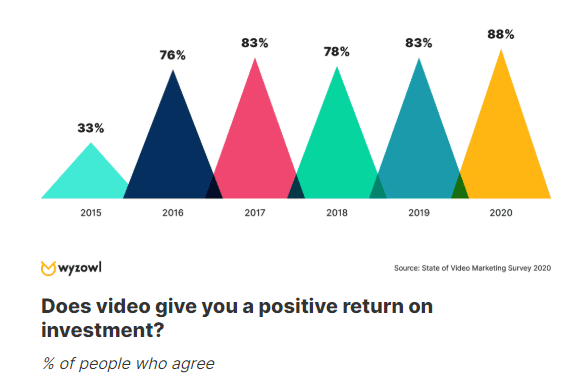
10 different types of video content
To enjoy all the benefits of promoting your business with video content, there are many types of videos you can create but here are 10 different types for your consideration:
1. Explainer videos
These are videos that are used to introduce and explain why your product or service is the solution to a specific problem a viewer is struggling with.
Explainer videos are popular and includes various types like:
- Animated explainer video
- Live action explainer video
- Whiteboard explainer video
2. Entertainment videos
These are interesting, short videos that are used to provoke different types of emotions and feelings in viewers in an entertaining manner.
Such videos may be funny, surprising, shocking, inspiring, motivating or even provoke a combination of two or more of these feelings.
3. Brand culture videos
Usually used to educate people about who you are as a business, and what you stand for, brand culture videos can also be used to introduce all the people working in your business.
This can give your business an attractive human face that draws viewers to your brand.
Examples of brand culture videos include:
- Employee interview videos
- Behind the scenes videos
- About us video
- “A day in the Office” video
- Holiday videos
4. Demo videos
As the name suggests, you can use demo videos to show a step by step process of how your product or service normally works.
Though similar to explainer videos, demo videos usually provide more detail about unique features and functions of a product or service.
5. Webinar videos
In most cases, this type of video is an online presentation used to educate viewers on relevant subjects or topics that has to do with a business, brand or industry.
Webinars can take place live or may be pre-recorded and can also be used to address questions about your product or service from your target audience and customers.
You’ll need the right software to help you run these types of videos. Check out Blogging Wizard’s article on the best webinar software to learn more.
6. Customer testimonial videos
In this kind of video, a customer usually explains a typical problem and how a product or service helped to solve the problem in a satisfactory manner.
To fully understand the impact of this type of video, check out these testimonial statistics from Wyzowl:
- 2 out of 3 people say they’re more likely to make a purchase after watching a testimonial video
- 79% of people have watched a video testimonial to learn more about a business, product or service
- 9 out of 10 people say they trust what a customer says about a business more than what the business says about itself
7. How To videos
Because people turn to search engines when they have a question or want to learn how to do something, you can create a How To video to answer questions your target audience are asking on search engines like Google.
Of course, this can go a long way to help you show up early in search results and also create more awareness for your business.
8. Personalized videos
This is a video that has been personalized for a specific viewer with the aid of technology by adding personal information like the viewers name, email address, profile picture and so on.
Personalized videos can be a powerful tool to surprise and delight customers, make them feel special and also make your business stand out in their minds for a long time.
9. Thank you videos
Just as the name implies, this type of video is used to show appreciation and say “thank you” to customers and subscribers at different times and for various reasons like:
- When a purchase is made
- When someone subscribes to your email list
- When a desired action is taken on your website
- When someone attends your event
- At the end of the year
- During holidays and festive seasons
10. FAQ videos
This is created for the sole purpose of providing answers to frequently asked questions (FAQ) that people are asking about a business or a product or a service.
Instead of answering these questions normally through a web page, a FAQ video is a more interesting and engaging alternative for the customer.
Answer these 3 questions before creating a video
Now that you know various types of videos you can create; it’s also important to be able to identify the best type or types that can help you achieve your purpose.
And to do that successfully, answer these 3 questions first before creating a video:
- What is your goal?
- Who is your target audience?
- Where can your audience be found online?
Next, let’s take a closer look and examine each question in more detail.
1. What is your goal?
Clearly, your goal is to gain as many customers as possible on a continuous basis.
But creating videos that ask people to buy from you won’t work, because that’s the wrong way to go about it.
Instead, you need to define your goal in terms of inbound marketing or methodology.
Before you ask, inbound marketing is a permission-based marketing that puts the customer first at all times.
It’s based on the principle that, first you try to turn strangers into readers, or viewers in the case of video content, before trying to turn them to customers.
And once they become customers, you should also try to turn them to fans that buy repeatedly.
In short, there are 4 different stages of inbound methodology as shown below:
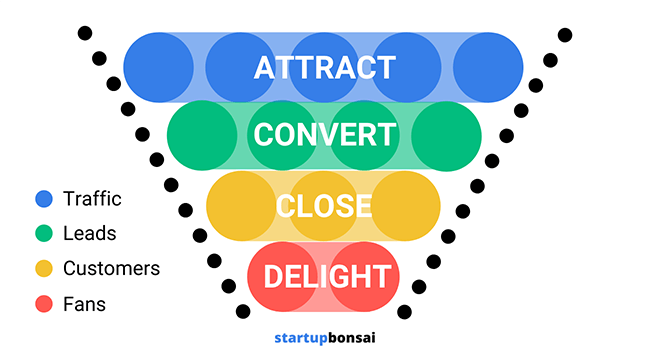
Stage One – Attract
Here, strangers are meant to be converted to visitors.
And you can do that by identifying the problems they’re struggling with and creating a video that provides a solution.
Such videos will not only attract them to your business but can also improve your credibility and make it easier for you to convert them to regular website visitors.
Examples of videos that are useful here are entertainment videos, explainer videos, how to videos, and brand culture videos
Stage Two – Convert
Now that you’ve attracted prospects who are watching your videos and visiting your website, the goal of this stage is to further strengthen the relationship by converting them to leads.
You can do that by asking for their contact information in exchange for providing valuable information they really need.
Relevant videos for this stage are demo videos, webinar videos, customer testimonial videos, how-to videos and FAQ videos.
Stage Three – Close
At this stage, your leads are still not sure whether to buy or not, so it’s up to you to convince and convert them to customers.
And you can do that by creating videos that highlight how well your product or service will meet their needs or solve their problems.
Such videos can include product demos, customer testimonial videos, brand culture videos and personalized videos.
Stage Four – Delight
Once they become customers, the relationship doesn’t have to end there.
Instead, continue to give them valuable content that can strengthen the bond and turn them into brand ambassadors and lifelong advocates of your business.
Types of video content needed here are thank you videos, personalized videos and FAQ videos.
2. Who is your target audience?
If you don’t know your target audience, most likely all your video marketing effort will be directed at the wrong people such as those who’re not interested in your products or services or don’t need them.
But with deep knowledge and understanding of your target audience, it becomes easier to create content that:
- Focuses on topics of interest to them
- Provide a solution to their problems
- Give them information they need but don’t have
- Answer questions they’re asking
To make this happen, do your research and learn everything about the identity of your target audience, including their:
- Age
- Gender
- Employment
- Geographical location
- Income level
- Interests and Hobbies
- Challenges and problems
3. Where can your audience be found online?
Because the online world is a vast one, identify those places where your target audience hang out online so you can concentrate your efforts there for best results
- Can they be found on Facebook or Instagram or LinkedIn?
- Are they already watching videos on YouTube or Vimeo?
- Do they belong to online forums like Reddit or Quora?
Once you have the right information, it becomes easier to create and upload relevant videos that are compatible with such platforms and can be shared successfully on them.
And in addition, the chances that members of your target audience will come in contact with your video and engage with it, increases dramatically.
15 video marketing tactics to gain more customers
So far, you’ve discovered the importance and benefits of video content marketing for businesses of all shapes and sizes
And you also have a solid idea of different types of videos you can create.
But it doesn’t end there.
You also need to be conscious of best practices and tactics that can make a positive difference in your video marketing effort.
And on that note, here are 15 tactics you need to produce a winning video and market it successfully, so you can gain more customers on a continuous basis:
1. Keep your videos under 2 minutes
From a research carried out by Wistia, it was discovered that optimal video length is two minutes.
Because videos up to two minutes long were observed to get a lot of engagement whether it’s a 70 second video or a 40 second video.
But after two minutes, the possibility of losing the attention of viewers increases.
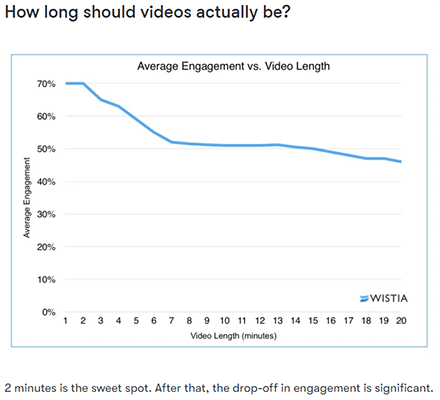
2. Tell interesting stories that provoke emotion
To attract and hold the attention of your viewers, always convert your message into an interesting and emotional story.
Whether you’re inspiring them or making them feel good about themselves or even causing them to laugh or cry, most likely you’ll get their attention long enough to get your message across and even remain in their mind for a long time.
And it’s also possible that such videos may be shared widely enough to make your business more popular.
3. Brand your videos
With countless videos out there, you can use branding to make your videos unique enough to stand out from others.
Always brand your videos using your brand logo, style, tone of voice, color, font, and so on, in a way that represents your business image and values.
Apart from making your videos easily recognizable, they will also look more professional, boost your credibility and help you earn the trust of your viewers.
4. Keep video titles short and informative
You can also make your video content stand out with a great video title that’s short but provides enough information at a glance.
Here are some tips to create a short video title that compels people to click and watch:
- Use numbers and lists
- Include relevant keywords
- Try to create curiosity
- Avoid misleading or dishonest information
- Be unique and specific
- Use a headline analyzer
- Keep it short, interesting and descriptive
5. Optimize your videos for mobile
With the increasing number of people that use mobile devices, you have to optimize your video content for mobile.
From the Q4 2019 Brightcove Global Video index, we have that:
- 55% of total video views were on smartphones
- 62% of all retail & marketing video views were on smartphones
Also, only 30% of people watch videos on their laptop / PC while 63% watch videos on mobile, according to Renderforest video marketing statistics.
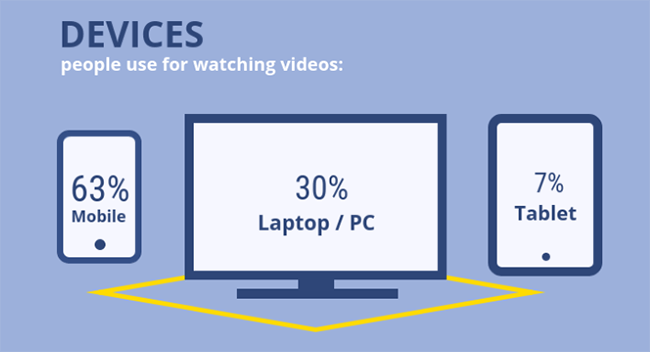
6. Insert a call to action (CTA)
With your goal at the back of your mind, always insert a call to action (CTA) in your video.
A CTA is a simple phrase used to encourage viewers to take a specific step after watching your video and can prompt them to do any of the following, among others:
- Watch another video
- Visit your website to enjoy a special offer
- Sign up for your newsletter
- Reach out to you on social media
Without a CTA in your video, don’t be surprised if the majority of your viewers fail to take any action after watching your video.
7. Add captions and subtitles to your videos
If you want a lot of people to watch your video and understand its value, then it’s in your best interest to add captions and subtitles to your videos.
Not sure what they are? That’s okay.
Captions and subtitles simply refer to those words written and displayed or scrolling at the bottom of a video or television screen while playing.
While captions are transcripts of the audio and are created for those with hearing challenges, subtitles are translations of the audio for those who can hear but may not understand the language or the speaker’s accent.
Benefits of adding captions and subtitles to your videos include:
- People with hearing issues can watch, understand and enjoy your video
- Those that can only watch videos in public can also watch, understand and enjoy your video with the sound turned off
- Non-native speakers of your language or those who have difficulty understanding foreign accents or are based in different parts of the world will also be able to watch, understand and engage with your video
8. Upload your video to video hosting platforms
Once your video is ready to be made available online, avoid hosting your video directly on your website because it can take up a lot of space and slow down your website, among other issues.
Instead, upload your video to a video hosting platform and then embed it on your website.
Here are some popular video platforms:
A. YouTube
YouTube is the biggest and most popular video hosting platform with 2 billion monthly logged-in viewers worldwide as at May 2019, according to Statista.
It’s the second largest search engine, next to Google and is also a social platform where viewers can engage with your videos in various ways.
Your videos can be uploaded free of charge and stands a higher chance of showing up in search results on both YouTube and Google.
But YouTube has plenty of adverts which can put some people off and on top of that, the huge audience means there are lots and lots of competition.
B. Vimeo
Vimeo is another popular video hosting platform with more than 150 million subscribers worldwide.
There’s less competition on Vimeo, the videos are usually of a much higher quality, and the subscribers behave in a more professional manner, compared to YouTube.
In addition, Vimeo promotes a stronger and more supportive community and the platform is free of ads.
Even though Vimeo has a free basic version with limited features, you need to spend money to enjoy all the value adding features they provide.
C. Vidyard
Vidyard is another ad-free video hosting platform created for businesses.
You can use it to host and store your videos, share them to other platforms online where your target audience can be found and also embed them on your website.
While there’s a free basic version, Vidyard provides 4 different pricing models that gives you additional features to boost your video marketing efforts.
In addition, Vidyard also makes it possible for you to create personalized videos for your target audience, subscribers and customers.
D. Wistia
Wistia is another video hosting platform that’s proud to help over 500,000 businesses grow with video because as far as they’re concerned, anyone can use video content to grow their business and brand.
Apart from a free plan that gives you access to standard features; they also have different paid plans with even more attractive features.
9. Embed your video on your website
To drive more traffic to your website and attract more and more visitors, embed videos on different pages on your website.
You can embed a video by placing a video embed code on your website which is displayed by pulling the video from the platform where the video is hosted.
According to a study carried out by Wistia, it was discovered that viewers spent an average 2.6x more time on pages with video than pages without.
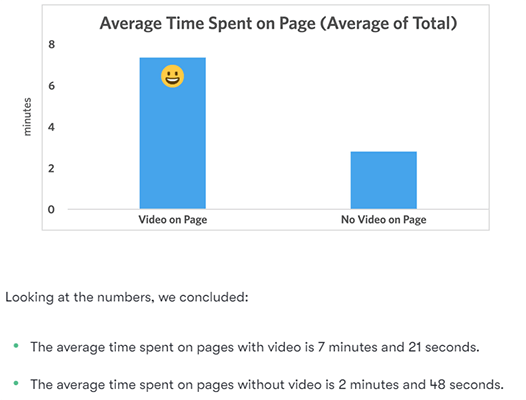
Added to that, recent video marketing statistics also show that:
- 93% of marketers regard video as an important part of their marketing strategy
- 87% of video marketers reported positive ROI from their video marketing efforts
10. Create branded custom thumbnails
Do you know that 90% of top performing videos on YouTube use a custom thumbnail?
In case you’re wondering, a thumbnail is a small clickable image used to identify your video in search results and previews of social media. It provides just enough information about your video content to influence viewers to click and watch.
Make use of the following tips to brand and customize your video thumbnails:
- Be consistent with style and design
- Choose a color scheme with nice contrasts
- Use images and fonts that are sharp and clear
- Use faces and facial expressions that represents your video content
- Include your logo or website
11. Encourage viewers to like, comment and share
Of course, the higher the number of likes, shares and comments, the more engagement your video has and the higher your chances of success with your video marketing.
People usually click on like buttons when they have a positive feeling but they comment to share their ideas, opinions and suggestions.
They also use share buttons to share content with their network when they believe the content is valuable enough.
Instead of leaving everything to chance, hoping viewers will comment, like your video and share it widely, just ask them to do so at the beginning or at the end of the video or both.
And remember to respond to all comments to further boost engagement.
12. Provide incentives to boost engagement
You can also boost engagement with your video by providing incentives and instant rewards for viewers that take a specific step or a desired action, such as watching the video to the end or commenting on the video or sharing the video and so on.
Such incentives may include any of the following, among others:
- A free gift
- A special discount
- A free course
- An eBook
13. Post your video to relevant social media sites
Can you believe that video content is the most preferred content on social media?
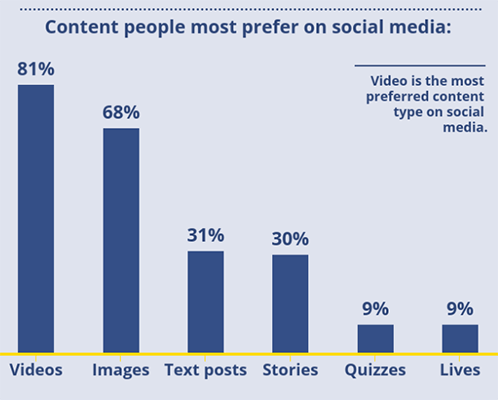
By posting your video on relevant social media where your audience are, you can grab the attention of a huge number of potential viewers since millions of people are active on different social media platforms.
In addition, most video marketers also plan to continue posting and marketing their videos on social media because of the valuable return on investment, according to recent video marketing statistics from Wyzowl as shown below:
- 76% of video marketers plan to include Facebook in their 2020 video marketing strategy
- 66% of video marketers plan to include LinkedIn in their 2020 video marketing strategy
- 65% of video marketers plan to include Instagram in their 2020 video marketing strategy
14. Use email to share your video
According to another study carried out by Wistia, having video thumbnails in their emails increased click-through rates by up to 40%.
You can add video to email just by placing a thumbnail in your email and linking it to a landing page on your website, where the video will play from.
For best results:
- Add the word “Video” to the email subject line
- Use a beautiful and attractive image as your video thumbnail
- Put a play button on the thumbnail to get people clicking
- Clicking the thumbnail should make your video start playing
- Place your clickable thumbnail below your email copy
- Avoid a lot of CTAs in an email with video
By using personalized emails to share your videos, not only will you boost your chances of getting more viewers, most likely your email and video marketing results will improve dramatically.
15. Provide transcripts of your videos
While transcripts and captions appear similar, they’re actually different and each has its own purpose and benefit.
A video transcript is the final output of a process known as transcription where all the words spoken in your video is converted to text either by human transcriptionists or with the aid of technology or by a combination of both.
Having transcripts of your video online can:
- Boosts your video SEO so it ranks higher in search engine results, all because search engines cannot read video yet
- Make your video searchable so people can search the transcripts for keywords or specific topics or phrases
- Help improve understanding of viewers especially for educational videos because it can serve as a form of reference and study guide
Beyond that, you can create an interactive transcript that’s time synchronized with the audio content of your video, so that it highlights the text as it’s spoken.
This provides a more engaging experience because once viewers click anywhere in the transcript, the video will start playing from that point.
Use video content to gain more customers
The simple truth is that video content marketing can help you gain more customers and grow your business beyond your wildest dreams.
But to begin with, you need to know your target audience and where they can be found online.
In addition, you also need a good understanding of the four stages of inbound marketing, the different types of videos relevant for each stage and key video marketing best practices.
In essence, not only can you create more awareness for your business with video content, you can also attract, engage and convert your target audience to repeat customers that buy again and again, on a regular basis.
